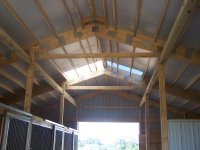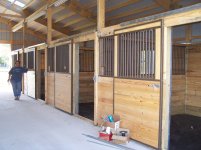For that extra $10K, you could buy a lot of extra implements or even a few extra horses for the barn...
With some help from family members, I built a 24 X 40 pole barn in 2001 (5 rib metal roof, exposed fasteners) and a 38 X 72 pole barn in 2013 (also 5 rib metal roof, exposed fasteners). Yes, on a frosty morning, it will "rain" inside when the frost on the underside of the metal melts- so the double bubble insulation is a good idea.
No one would want the fasteners to leak on such a big investment- that's why I placed the screws through the ribs instead of through the flats. No leaks and no screw replacements on either roof for all of those years! Many contractors do not want to place the screws through the ribs because it takes longer and requires more skill (if you over-tighten the screws, it will flatten the rib a little and deform the sheet, which can throw the roofing off square). If you go with exposed fasteners, talk to folks with roofs that were done both ways and see who has had the most leaks and has had to replace any fasteners. Be aware that you may have to look around a little for a contractor who is willing to place the screws through the ribs. I was even told by one contractor "we don't do it that way because it will leak"- trust me, it won't if you maintain the proper overlap/flashing etc.

